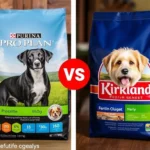
Introduction
Dog nutrition is an essential aspect of responsible pet ownership. Proper nutrition not only influences a dog’s growth, energy levels, and overall health, but it also plays a critical role in their longevity and quality of life. When dog owners understand the importance of balanced nutrition, they can make better choices for their furry friends, ensuring they thrive at every life stage.
This article aims to inform readers about the current dog food trends shaping the industry and provide guidance for dog owners in making informed nutritional choices. Whether you’re a new dog owner or a seasoned pet parent, staying updated on trends can help you provide the best for your canine companion.
Understanding Dog Nutritional Needs
Essential Nutrients for Dogs
To maintain optimal health, dogs require a balanced diet that includes several essential nutrients:
- Proteins: Proteins are vital for growth, repair, and maintenance of tissues. High-quality protein sources include chicken, beef, fish, and eggs.
- Fats: Healthy fats, such as omega-3 and omega-6 fatty acids, play a crucial role in skin health, coat quality, and overall energy. Sources include fish oil and flaxseed.
- Carbohydrates: While dogs can derive energy from carbohydrates, it’s essential to choose healthy sources like sweet potatoes, brown rice, and peas to avoid digestive issues.
- Vitamins and Minerals: Key vitamins (A, D, E, K, and B-complex) and minerals (calcium, phosphorus, and potassium) are critical for various bodily functions, such as bone health, immune support, and metabolic processes.
Life Stage and Lifestyle Considerations
A dog’s nutritional needs can vary significantly based on age and lifestyle:
- Puppies: Require higher protein and fat levels for growth and development.
- Adults: Need a balanced diet to maintain health and weight.
- Seniors: May require lower calories and specific nutrients to address age-related health issues.
Lifestyle factors, such as activity level, also influence dietary requirements. Active dogs may need more calories and proteins than their sedentary counterparts.
Common Health Issues and Dietary Solutions
Many dogs face health challenges that can be mitigated through proper nutrition:
- Allergies and Sensitivities: Dogs may develop allergies to certain ingredients, leading to skin irritations or gastrointestinal issues. Limited ingredient diets can help identify and avoid allergens.
- Obesity and Weight Management: Overweight dogs can suffer from various health issues. A balanced diet and controlled calorie intake are crucial for weight management.
- Digestive Issues: Conditions like irritable bowel syndrome can be alleviated through specialized diets that include easily digestible ingredients and probiotics.
Current Trends in Dog Food
Natural and Organic Dog Foods
The demand for natural and organic dog foods has surged in recent years. These products typically contain fewer artificial ingredients and preservatives, focusing instead on whole, natural components. Benefits of natural dog foods include:
- Improved digestion
- Healthier skin and coat
- Reduced risk of allergies
Popular natural ingredients include sweet potatoes, lentils, and chickpeas, all of which provide essential nutrients without synthetic additives.
Grain-Free and Limited Ingredient Diets
Grain-free diets have gained popularity, primarily due to the belief that grains can contribute to allergies and digestive problems. However, it’s essential to approach this trend with caution. While there are benefits, such as improved digestibility for some dogs, there are also potential risks, including the development of canine dilated cardiomyopathy (DCM) linked to certain grain-free diets.
Limited ingredient diets focus on using minimal ingredients to reduce the likelihood of allergic reactions. These diets can be beneficial for dogs with sensitivities but may lack essential nutrients if not properly formulated.
Raw and Freeze-Dried Diets
The raw feeding trend advocates for a diet consisting of uncooked meats, bones, fruits, and vegetables. Proponents argue that this diet mimics a dog’s natural eating habits, leading to better health. However, raw diets come with risks, including exposure to harmful bacteria and imbalances in nutrients.
Freeze-dried diets offer a convenient alternative by preserving raw ingredients while eliminating moisture. This method retains most nutrients, making it a popular choice for dog owners seeking a raw diet without the preparation hassle.
Functional Dog Foods
Functional dog foods incorporate specific ingredients designed to address particular health concerns. For example, foods rich in probiotics can aid digestion, while those containing antioxidants may support a healthy immune system. These specialized diets can be beneficial for dogs with specific health issues or those needing preventive care.
Customizable and Personalized Dog Nutrition
The rise of subscription-based meal delivery services has made customizable dog nutrition more accessible. These services analyze a dog’s individual needs, factoring in age, weight, activity level, and health concerns to create tailored meal plans. This trend empowers dog owners to provide a balanced diet that meets their pet’s specific requirements.
Assessing Dog Food Quality
Understanding Dog Food Labels
When selecting dog food, understanding the label is crucial. Here are key components to look for:
- Ingredients list: The first few ingredients should include high-quality protein sources.
- Guaranteed analysis: This section provides information on the nutrient content, including protein, fat, fiber, and moisture.
- Feeding guidelines: Ensure the food provides enough calories and nutrients for your dog’s specific needs.
Ingredient sourcing is also vital; high-quality ingredients can significantly impact your dog’s health.
AAFCO Standards
The Association of American Feed Control Officials (AAFCO) establishes guidelines for pet food labeling and nutrient profiles. AAFCO approval indicates that a dog food product meets specific nutritional standards, providing reassurance to dog owners about its quality.
Recognizing Marketing Gimmicks
The pet food industry is rife with marketing gimmicks that can mislead consumers. Common myths include:
- “Grain-free is always better”: This isn’t true for every dog. Some dogs thrive on grains.
- “All-natural means healthy”: Not all natural ingredients are beneficial; some can be harmful.
- “Human-grade food is superior”: This can be misleading, as “human-grade” doesn’t always equate to better nutrition.
To make informed choices, dog owners should rely on scientific research rather than marketing claims.
Making Informed Choices
Consulting Veterinary Professionals
When it comes to dog nutrition, consulting veterinary professionals is invaluable. Vets can provide personalized dietary advice, ensuring that the chosen food meets your dog’s specific needs. Questions to consider asking include:
- What should I look for in a dog food brand?
- Are there specific dietary restrictions for my dog?
- How can I manage my dog’s weight effectively?
DIY Dog Food: Pros and Cons
Some dog owners choose to prepare homemade meals for their pets. While DIY dog food can be beneficial, it’s essential to consider both pros and cons:
Pros:
- Control over ingredients
- Ability to address specific health issues
- Freshness and quality assurance
Cons:
- Risk of nutritional imbalances if not well-researched
- Time-consuming preparation process
- Potential food safety concerns
If considering a homemade diet, it’s crucial to consult with a veterinarian or a pet nutritionist to ensure your dog receives all the necessary nutrients.
Transitioning to New Dog Food
Switching your dog’s food should be done gradually to avoid digestive upset. Here are best practices for transitioning:
- Start slow: Mix a small amount of the new food with the current food.
- Gradually increase: Over the course of 7 to 10 days, slowly increase the proportion of new food.
- Monitor your dog: Watch for any signs of distress, such as vomiting, diarrhea, or changes in appetite.
If you notice any adverse reactions, consult your veterinarian.
Future Trends in Dog Nutrition
Sustainable and Ethical Dog Food Options
As pet owners become more environmentally conscious, the demand for sustainable and ethical dog food options is on the rise. Brands that prioritize sustainable sourcing, eco-friendly packaging, and ethical manufacturing processes are gaining popularity. Choosing these brands not only supports a healthier planet but often results in higher-quality products for pets.
Technological Advancements in Dog Nutrition
Technological advancements are playing a significant role in the future of dog nutrition. Innovations in pet food manufacturing, such as precision nutrition and enhanced ingredient analysis, are making it easier to create tailored diets for dogs. The use of technology can also help in monitoring a dog’s health and dietary needs more effectively, ensuring they receive the best possible nutrition.
Conclusion
Proper dog nutrition is a cornerstone of a healthy and fulfilling life for our canine companions. Understanding the latest dog food trends can empower pet owners to make informed decisions regarding their dog’s diet. By consulting with veterinary professionals, staying updated on nutritional advancements, and being aware of marketing tactics, dog owners can provide the best possible care for their furry friends. Staying proactive and educated about your dog’s diet is vital for their longevity and happiness.









